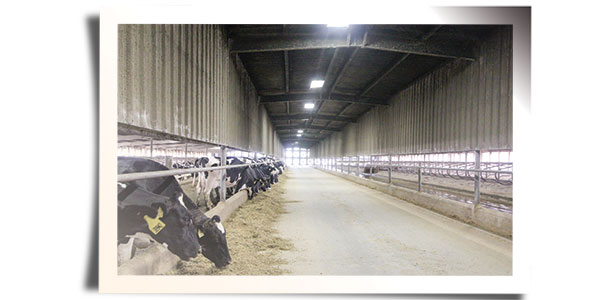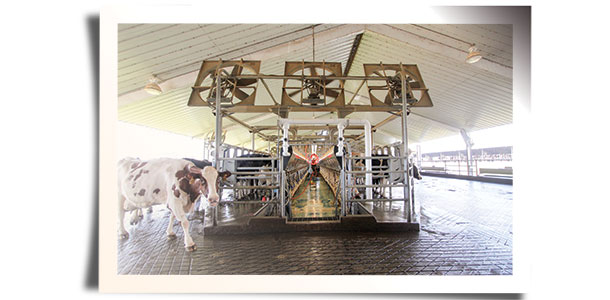Leaving behind the winter-gripped Northeast, 40 dairy producers boarded a bus in Tallahassee for three days touring Florida-Georgia line dairies during the Professional Dairy Managers of Pennsylvania (PDMP) 2015 March Dairy Tour. Tour-goers were quite curious how dairy managers in the South coax 82 to 95 pounds per cow per day and 120,000 to 180,000 SCC in the region’s heat and humidity.
Sand bedding, of course, was featured prominently. The gradual shift from drylots and shade cloth to putting milking herds, even dry cows, under a roof in very tall, open barns with sand bedding, sprinklers and fans – or with tunnel ventilation as was seen at North Florida Holsteins – has transformed the region’s dairy production landscape.
Better facilities, better cooling, adapted feeding programs and genetics for “rugged cows,” as Don Bennink describes them – along with the emphasis on adding cows and maintaining a least-cost approach so as not to subtract from the profit potential of the cow as the single best investment on a dairy – have propelled milk production in Georgia and Florida to a combined 4.2 billion pounds for 2014, up 18 percent from 2010, which was the year a decade of slump turned around.
While similar in size – 3,000 to 4,000 cows per location with multiple locations, one central location for calving and growth occurring in increments of 600 to 1,000 head – each had their own way of doing things and their own experiences to share about how they got started here.
Many of the dairy owners found partnering opportunities as transplants from New York and are now part of a 40-year root system for dairy business culture in the northern Florida and southern Georgia region, where dairy is among the top 10 commodities.
A Cornell graduate, Calvin Moody, for example, worked in partnership with the former owner of his first dairy, Brooksco, and has continued to add partners in other locations. His cow and business sense keep him in the driver’s seat as managing partner, and he delegates to general managers at each location. Moody hires 12 custom growers to work the land and strives to keep two years of feed in storage as a hedge against weather and markets.
Brooksco had the hallmark of extreme cleanliness and organization. Not only was sand used for cow bedding but also for calves. The 2,800-cow location is the mother ship for two satellites, and it’s where the cows calve.

At Leatherbrook Holsteins, tour-goers enjoyed discussions with Dr. Adam Graft, another transplant, who moved from his home in Ohio to California where he had a small dairy and a veterinary practice. Having earned his undergraduate degree at the University of Georgia and married a Georgian, his interests were brought here, where the attention is focused on dry cow health (and cooling) to minimize calving difficulties and timed A.I. for breeding efficiency.
Both Moody and Graft believe in simplifying animal care and use a centralized model for calving. Moody notes that the single biggest thing he has done to improve calf performance is thrice-daily feeding of a 28/15 milk replacer and to provide fresh bedding sand once daily there as well.
Tourgoers learned that land ownership is important, and triple-cropping uses more manure and yields more feed; however, land ownership takes a back seat to developing people and cows here. Dairy owners have skilled workforces doing much of the building and repairs as well as the animal health work.
“Two things count: The cows, of course, and getting along with people to make this a fun place to work,” said Peter Gelber at Barrington and Highbrighton Dairies, Montezuma, Georgia. “We also have to be clear on our needs versus our wants.”
As a young man from the Bronx with a degree from Cornell, Gelber was given loose rein to run the two Georgia dairies purchased a decade ago by Ron St. John of Alliance Dairies, Trenton, Florida. After turning them around, the two men worked out a partnership deal where Gelber and his wife, Dr. Elizabeth Reid, and son Richard now own them.
“The summers here are rough on cows but not as much as they used to be,” Gelber explained. “We focus on nutrition (less carbs/more effective fiber) and feet. We want them not too fat or too skinny, and we want a smaller cow with more productive life.” Gelber houses 2-year-olds and 3-year-olds separately. On Mondays they move low-enders out and prefresh in.
Gelber stressed no investment is as profitable as adding another cow. In that mode, his dairies have practically doubled, without purchased cows or sexed semen. He has empowered employees with a keen eye for finding sick cows and doesn’t waste time on problem breeders. At current beef prices, “a dairy’s cull rate is not what matters when a healthy, profitable heifer can take her place,” he said.
The higher lignin content and slower rates of passage of the forages grown in the South make ration forage inclusion rates lower (45 percent) than in the North. Rations utilize more combinations of NDF as dairy producers typically grow two crops of irrigated and digestible-trait corn silage as well as sorghum silage, oatlage, earlage, wheatlage, ryelage, coastal hay and a good-milking relative newcomer: ryegrass silage.
“The cows could never eat enough of our forages to make the milk production volume we like to see,” said Ron St. John. “So we feed less of it and add commodities that provide more digestible NDF.” Widely available and cost-effective in the Southeast, of course, citrus pulp is part of every ration.

Of interest at North Florida Holsteins was Bennink’s international training program, where future dairy managers come from all over the world to learn dairy efficiency and genetics techniques.
“They go on to become the dominant dairy managers in their home countries,” said Bennink, who moved from western New York to Bell, Florida, in 1980 and grew his dairy, converting drylots to tunnel-ventilated and sand-bedded freestall barns and developing his own system of genetic selection.
“I like my cows tough and rugged – resilient – and highly productive,” said Bennink, steering away from “showy sharpness” and toward strong-bodied cows with good productive life and health traits as well as pounds of protein. Tour-goers noticed the great udders and uniformity of the heifer groups.
Just 12 miles from North Florida Holsteins are Ron St. John’s three “natural housing” dairies totaling 12,000 cows. Joey Ricks, one of the three “next generation” potential partners coming into the business, manages these dairies, which are a separate business from St. John’s 6,000-cow Alliance Dairies.
His goal is for both types of dairies to be highly profitable – and that is challenged with the natural housing due to the lower volume of production. While Alliance Dairy has production of 85 pounds per cow per day, the natural-housing dairies are at 58 to 60 pounds per cow per day.
St. John’s focus for both is to be a least-cost producer. He evaluates decisions, performance and profitability by looking at return on assets (ROA). He sees the natural-housing dairies as less profitable than Alliance right now but is working on improving the model.
St. John also hails from western New York but has dairied in Florida for four decades now. He got his start by partnering with a crop farmer who is still a silent partner, and he talked about how he is working on the transition of the dairy to his daughter, Jan, and two other partners with the help of Elwyn and Jennifer Voss of The Voss Group, based in Norwich, New York.
Tour-goers learned about the communication and emotional aspects of dairy transitions that trump the financial side in their importance to the process. PD
Sherry Bunting is a freelance writer based in East Earl, Pennsylvania.
Click here to see more photos from this bus tour.
PHOTOS
TOP: Dr. Adam Graft focuses on cow comfort and cooling, especially the dry cows. He positions waterers beneath fans for super-charged cooling.
MIDDLE: Don Bennink has gradually moved to tunnel-ventilated freestall barns at North Florida Holsteins.
BOTTOM: Super-clean milking prep and sand bedding are the secret at Calvin Moody’s Brooksco Dairy, where barns are flushed four times a day and fresh bedding sand added once a day. The 2,800 milk cows at this location produce an RHA of 29,000 pounds.Photos courtesty of Sherry Bunting.





